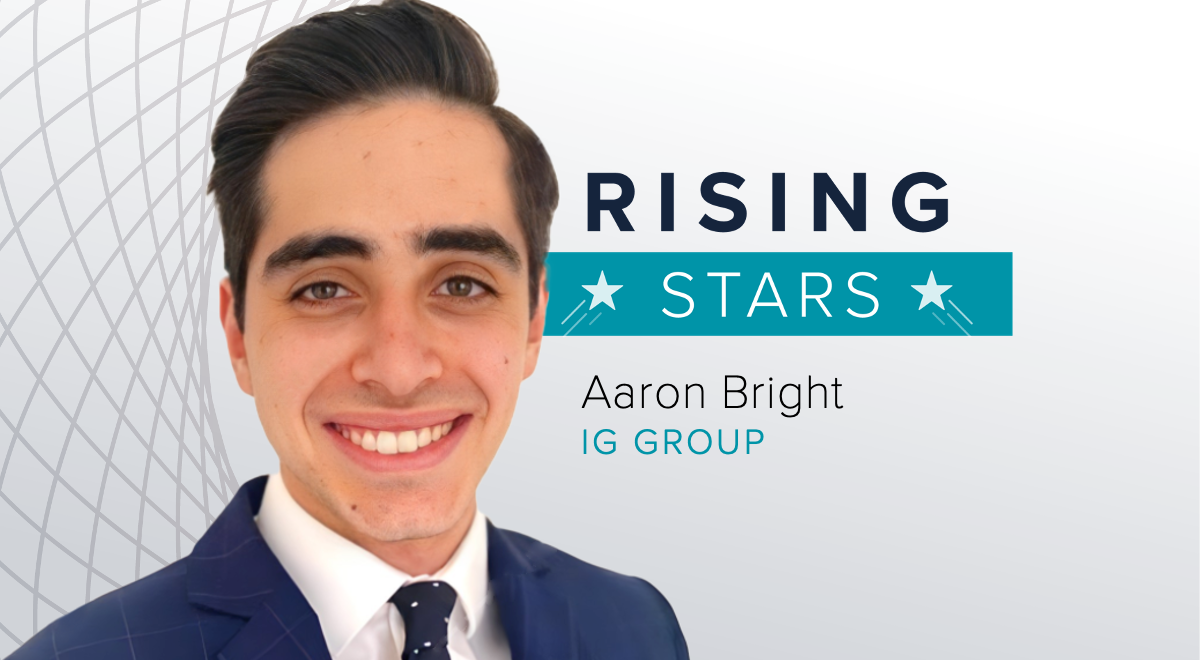The next instalment of our Rising Stars series sees IG assistant portfolio manager Aaron Bright speak to ETF Stream about making the switch from financial planning to fund selection, Royal Navy role models and the need for greater access to ETFs on adviser platforms.
Bright started his career as a trainee financial adviser at Vintage Wealth Management, then spending almost two years as an investment analyst at NLP Financial Management before joining IG in November 2022.
How did you get into fund selection?
My interest in financial markets started from a young age and after studying economics and politics at university, I got a job in wealth management. I originally wanted to become a wealth manager and then about a year in, I realised I wanted to focus exclusively on the markets side, on portfolio construction and generating returns for clients, rather than being a holistic financial planner.
I made the switch into being a multi-asset analyst at a wealth management firm where I spent two years covering equities, bonds and alternatives, recommending funds to the investment committee and assisting with tactical and strategic asset allocation.
About a year-and-a-half ago, I got the offer from IG to take a step up and co-manage a passive portfolio range. The Smart Portfolio range of multi-asset portfolios is entirely made up of passive iShares ETFs, because that is where we get our asset allocation research from.
Where I previously worked, I played a role in managing 10 portfolios, seven regular passive-active blend portfolios and three ESG portfolios.
What role do you play within your team?
It is quite a small team. IG is known for its leveraged business so Smart Portfolios are a small part of IG’s suite of products and it is just two of us managing the portfolios.
My role is very diverse. My main responsibility is co-managing the portfolios, large swathes of which revolves around macro-economic research, market analysis, monitoring portfolio performance, attribution reporting and constantly looking to see if we should make changes and what our outlook is from a macro, geopolitical and valuation perspective.
We sit in the product team at IG so we are also playing a role in reviewing our non-leveraged product mix and how we can improve and refine it.
Another part of my role is discussing macro and performance to internal and external media, which is something I really enjoy and look forward to doing more of.
What type of investor do you see yourself as?
I am definitely someone who prides themselves on being patient and long-term. Often the best thing is to build a risk-adjusted, strategic asset allocation, but in certain cases, applying tactical tweaks to a portfolio is useful to capitalise on dislocations in valuations and geopolitics – recently we increased our gold position in light of the Israel-Hamas war breaking out.
I would not describe myself as strictly a growth or value investor, more a mix of the two. I have been told I am a value style bear, but you always have to be aware of how much you are paying for an exposure and you also need to keep growth generation in mind. Both elements influence the way I construct portfolios.
Who are your biggest role models?
I am aware this might be a bit blasphemous to say to an ETF publication, but one would have to be Nick Train. He was someone I came across as a teenager and the way he approaches investing is ingenious. When I first heard him speak, it made me really appreciate the importance of concepts such as valuation, quality, discipline and time are in portfolio management.
On the multi-asset side, I would have to say the late Harry Markowitz – I have tried to draw a lot of wisdom from reading his works. Concepts like modern portfolio theory, diversification, portfolio optimisation shape so much of what I and other investors do day-to-day and that epitomises why he is such a source of influence.
Outside of finance, someone I look up to but never met was my great grandfather. He joined the Royal Navy as a deck scrubber as a teenager and progressed to becoming a decorated naval commander, serving in both world wars and while he died well before I was born, hearing his story growing up made me realise that through hard work and determination, achieving great things is possible.
What is a particular area of interest or something you enjoy about ETFs?
You can do pretty much anything and build any combination of exposures using ETFs. If we want small-cap exposure or short-duration US Treasuries, we can buy exposures to suit our needs with ease.
You can get ultra-granular in areas such as fixed income. We can go across whole yield curves and closely manage our duration and interest rate risk by building a barbell using ETFs.
Given the sheer array of ETFs in the space – and their agility and liquidity – putting our ideas into practice for clients is made much simpler.
As an active manager, I am always keeping a look-out for the active products that are launching and it would be great to see this space continue to grow.
Where is further development needed in the fund selection space?
A major reason ETFs are not as popular in the UK as they are in Europe is because these large wrapper platforms – particularly adviser platforms – just are not offering them.
We need better access to ETFs through UK fund platforms, particularly adviser-led ones, to break down this barrier and give the ETF industry a huge boost in the UK, with the potential for substantial growth in passive instruments and potentially also active ETFs. Investment management companies are likely to launch active ETFs if they can be bought on adviser platforms.
Breaking down these barriers would open up flows from the wealth management space and potentially even more from retail clients.
As a portfolio constructor, you want to have all the tools available. When I was managing portfolios previously, we could not access gold ETFs on a lot of the platforms, so we had to use a gold shares fund, which does well when times are good but leveraged exposure does horrendously when gold falls in price – when realistically all we wanted was a gold ETC exposure.



